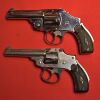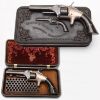Driftwood Johnson
Member
Howdy
I am starting this thread in answer to WestKentucky who asked me in a private message about some grips on one of my old S&W Top Breaks. For some reason, I cannot post photos in private messages, so I am starting a new thread to explain and show some photos.
First off, S&W always calls them stocks, not grips, but we will call them grips because it is simpler.
The question was what are the grips on my old 38 Single Action, 2nd Model. This photo shows both a 38 Single Action 1st Model (often called the Baby Russian) at the top and the 38 Single Action 2nd Model in question at the bottom. These are typical Hard Rubber grips. Hard Rubber was a very early form of plastic. It is formed by treating crude rubber with a large amount of sulfur and subjecting it to intense heat. Hard rubber grips were probably used because they could be molded complete with checkering and the S&W logo at the top. Wooden grips would have required carving and checkering to achieve the same effect, so it was probably more cost effective to use Hard Rubber than wood. Smith and Wesson started using Hard Rubber for grips in the late 1870s, which jives perfectly with these two old revolvers, the Baby Russian shipped in 1876, the 2nd Model shipped in 1877. I got curious and took the grips off, and sure enough they both have the serial numbers of the guns written in pencil on the underside of the right grip, verifying the revolvers shipped with these grips. Yes, it would be possible to fake that, but these grips do not add all that much value, so I doubt anyone would bother. Although the outer surface of this type of grip was completely formed when it popped out of the mold, the underside of every pair I have inspected has usually been lightly sanded on a flat plate to flatten the surface out so it will fit snuggly on the grip frame. The grips on the Baby Russian are still the dark black they were when they were shipped. The grips on the 2nd Model have faded over time and they are more of a greenish gray in color.

A 32 Safety Hammerless from 1905 that WestKentucky asked about. These grips have been stamped with the serial number of the gun.

A 32 Single Action from 1889 with Hard Rubber grips in nice condition.

Hard Rubber was used for more than gun grips. Bowling balls, hockey pucks, fountain pens, were just a few of the products made with Hard Rubber in the early 20th Century. Because it is an excellent electrical insulator early electric plugs were made from Hard Rubber. Do not confuse Hard Rubber with Bakelite, another early plastic. Unlike Hard Rubber, Bakelite was made from synthetic components.
Hard Rubber grips from 100 years ago tend to dry out over time. This makes them very brittle. One has to be very careful removing them from a gun, lest they crack or break.
Prior to the late 1870s, most S&W Top Break revolvers came with wooden grips, like this 2nd Model Russian, which shipped in 1875.

Or this 1st Model Schofield which also shipped in 1875.

According to the Standard Catalog of Smith and Wesson, my bible for this kind of stuff, Hard Rubber grips eventually became standard on Smith and Wesson Top Break revolvers. In this photo we see a big New Model Number Three that shipped in 1882 and its little brother a 38 Single Action 3rd Model. I have not determined exactly when the 38 shipped, probably sometime before 1911. The entwined S&W logo on these was standard. Again, easy to cast, probably very expensive to carve.

A 38 Safety Hammerless 2nd Model with Hard Rubber grips with the entwined S&W logo.

A 38 Double Action and 32 Double Action with Hard Rubber grips. The 38 shipped in 1898, I do not know when the 32 shipped.

A pair of 38 Double Action Perfecteds with Hard Rubber grips. The blued one shipped in 1912, the nickel plated one shipped in 1917.

Smith and Wesson continued to use Hard Rubber grips well into the Hand Ejector era. This 38 HE Model of 1899 shipped in 1899 with these grips. I have a round butt 38 HE that shipped in 1939 with Hard Rubber grips.

One thing I do not have in my collection is a revolver with the red, mottled Hard Rubber grips.
Here is a link to a 32 Safety Hammerless Bicycle Revolver with red mottled Hard Rubber grips. These grips are prized by S&W collectors.
https://www.icollector.com/Smith-We...-barrel-blue-finish-factory-mottled_i13667905
Smith and Wesson was not the only company using Hard Rubber grips. This well worn Colt Bisley from 1909 has Hard Rubber grips that have faded a bit with time.

The grips on this Colt Bisley which shipped in 1907 have not faded as much.

A Colt Army Special and a Police Positive Special as well as a couple of 32 Police Positives with Hard Rubber grips.

A couple of Merwin Hulberts with Hard Rubber grips.

One other thing. When Ruger first brought out the New Vaquero, the grips were advertised as being Hard Rubber. They are not, they are injection molded plastic.
I am starting this thread in answer to WestKentucky who asked me in a private message about some grips on one of my old S&W Top Breaks. For some reason, I cannot post photos in private messages, so I am starting a new thread to explain and show some photos.
First off, S&W always calls them stocks, not grips, but we will call them grips because it is simpler.
The question was what are the grips on my old 38 Single Action, 2nd Model. This photo shows both a 38 Single Action 1st Model (often called the Baby Russian) at the top and the 38 Single Action 2nd Model in question at the bottom. These are typical Hard Rubber grips. Hard Rubber was a very early form of plastic. It is formed by treating crude rubber with a large amount of sulfur and subjecting it to intense heat. Hard rubber grips were probably used because they could be molded complete with checkering and the S&W logo at the top. Wooden grips would have required carving and checkering to achieve the same effect, so it was probably more cost effective to use Hard Rubber than wood. Smith and Wesson started using Hard Rubber for grips in the late 1870s, which jives perfectly with these two old revolvers, the Baby Russian shipped in 1876, the 2nd Model shipped in 1877. I got curious and took the grips off, and sure enough they both have the serial numbers of the guns written in pencil on the underside of the right grip, verifying the revolvers shipped with these grips. Yes, it would be possible to fake that, but these grips do not add all that much value, so I doubt anyone would bother. Although the outer surface of this type of grip was completely formed when it popped out of the mold, the underside of every pair I have inspected has usually been lightly sanded on a flat plate to flatten the surface out so it will fit snuggly on the grip frame. The grips on the Baby Russian are still the dark black they were when they were shipped. The grips on the 2nd Model have faded over time and they are more of a greenish gray in color.

A 32 Safety Hammerless from 1905 that WestKentucky asked about. These grips have been stamped with the serial number of the gun.

A 32 Single Action from 1889 with Hard Rubber grips in nice condition.

Hard Rubber was used for more than gun grips. Bowling balls, hockey pucks, fountain pens, were just a few of the products made with Hard Rubber in the early 20th Century. Because it is an excellent electrical insulator early electric plugs were made from Hard Rubber. Do not confuse Hard Rubber with Bakelite, another early plastic. Unlike Hard Rubber, Bakelite was made from synthetic components.
Hard Rubber grips from 100 years ago tend to dry out over time. This makes them very brittle. One has to be very careful removing them from a gun, lest they crack or break.
Prior to the late 1870s, most S&W Top Break revolvers came with wooden grips, like this 2nd Model Russian, which shipped in 1875.

Or this 1st Model Schofield which also shipped in 1875.
According to the Standard Catalog of Smith and Wesson, my bible for this kind of stuff, Hard Rubber grips eventually became standard on Smith and Wesson Top Break revolvers. In this photo we see a big New Model Number Three that shipped in 1882 and its little brother a 38 Single Action 3rd Model. I have not determined exactly when the 38 shipped, probably sometime before 1911. The entwined S&W logo on these was standard. Again, easy to cast, probably very expensive to carve.

A 38 Safety Hammerless 2nd Model with Hard Rubber grips with the entwined S&W logo.

A 38 Double Action and 32 Double Action with Hard Rubber grips. The 38 shipped in 1898, I do not know when the 32 shipped.

A pair of 38 Double Action Perfecteds with Hard Rubber grips. The blued one shipped in 1912, the nickel plated one shipped in 1917.

Smith and Wesson continued to use Hard Rubber grips well into the Hand Ejector era. This 38 HE Model of 1899 shipped in 1899 with these grips. I have a round butt 38 HE that shipped in 1939 with Hard Rubber grips.

One thing I do not have in my collection is a revolver with the red, mottled Hard Rubber grips.
Here is a link to a 32 Safety Hammerless Bicycle Revolver with red mottled Hard Rubber grips. These grips are prized by S&W collectors.
https://www.icollector.com/Smith-We...-barrel-blue-finish-factory-mottled_i13667905
Smith and Wesson was not the only company using Hard Rubber grips. This well worn Colt Bisley from 1909 has Hard Rubber grips that have faded a bit with time.

The grips on this Colt Bisley which shipped in 1907 have not faded as much.
A Colt Army Special and a Police Positive Special as well as a couple of 32 Police Positives with Hard Rubber grips.

A couple of Merwin Hulberts with Hard Rubber grips.

One other thing. When Ruger first brought out the New Vaquero, the grips were advertised as being Hard Rubber. They are not, they are injection molded plastic.
Last edited:










